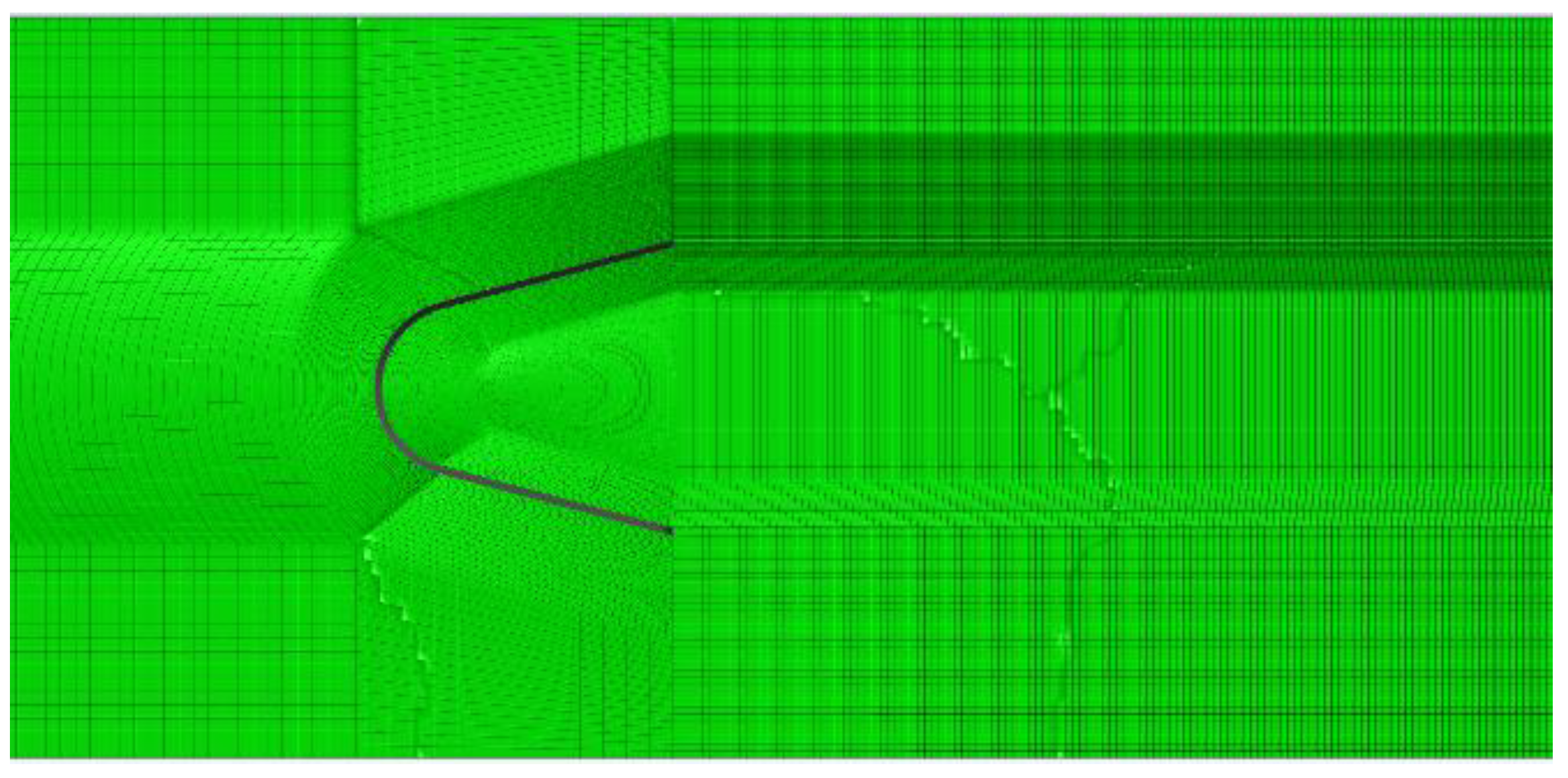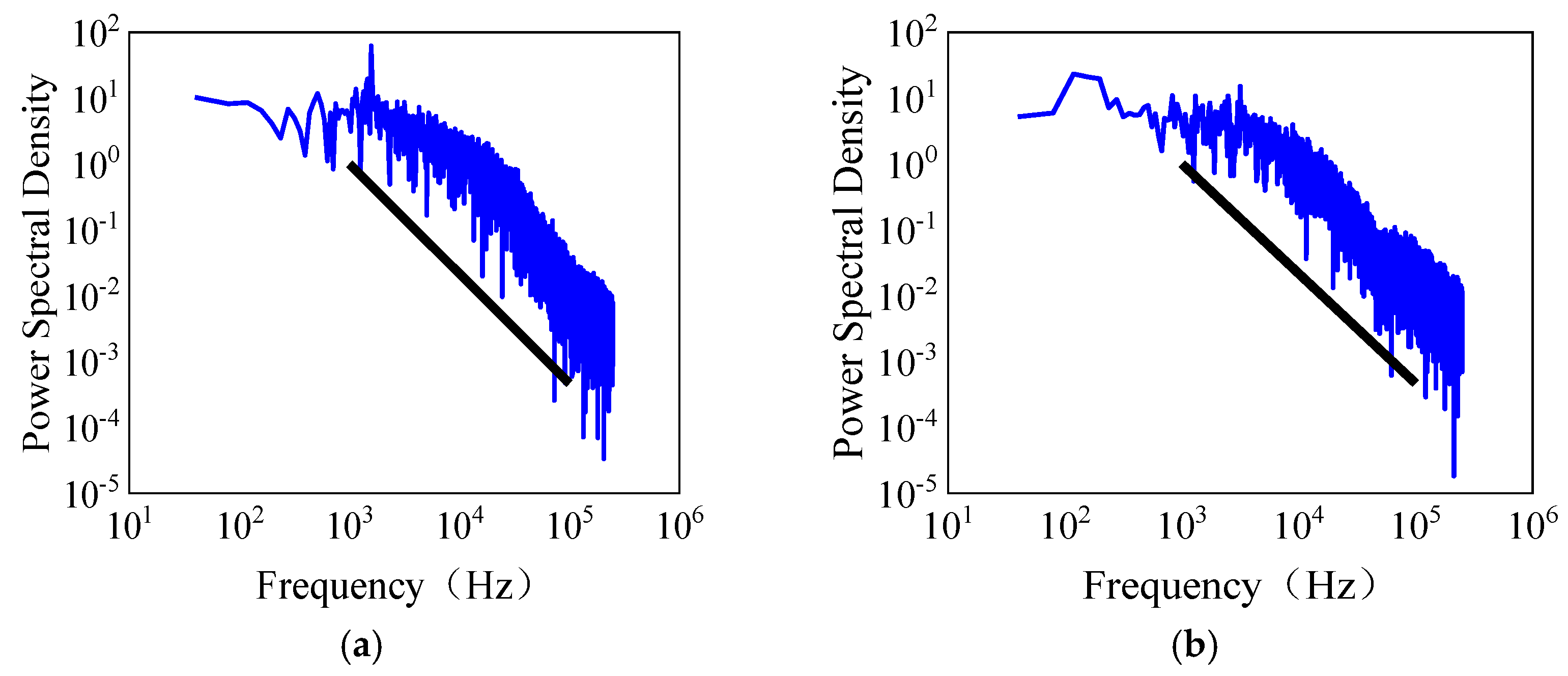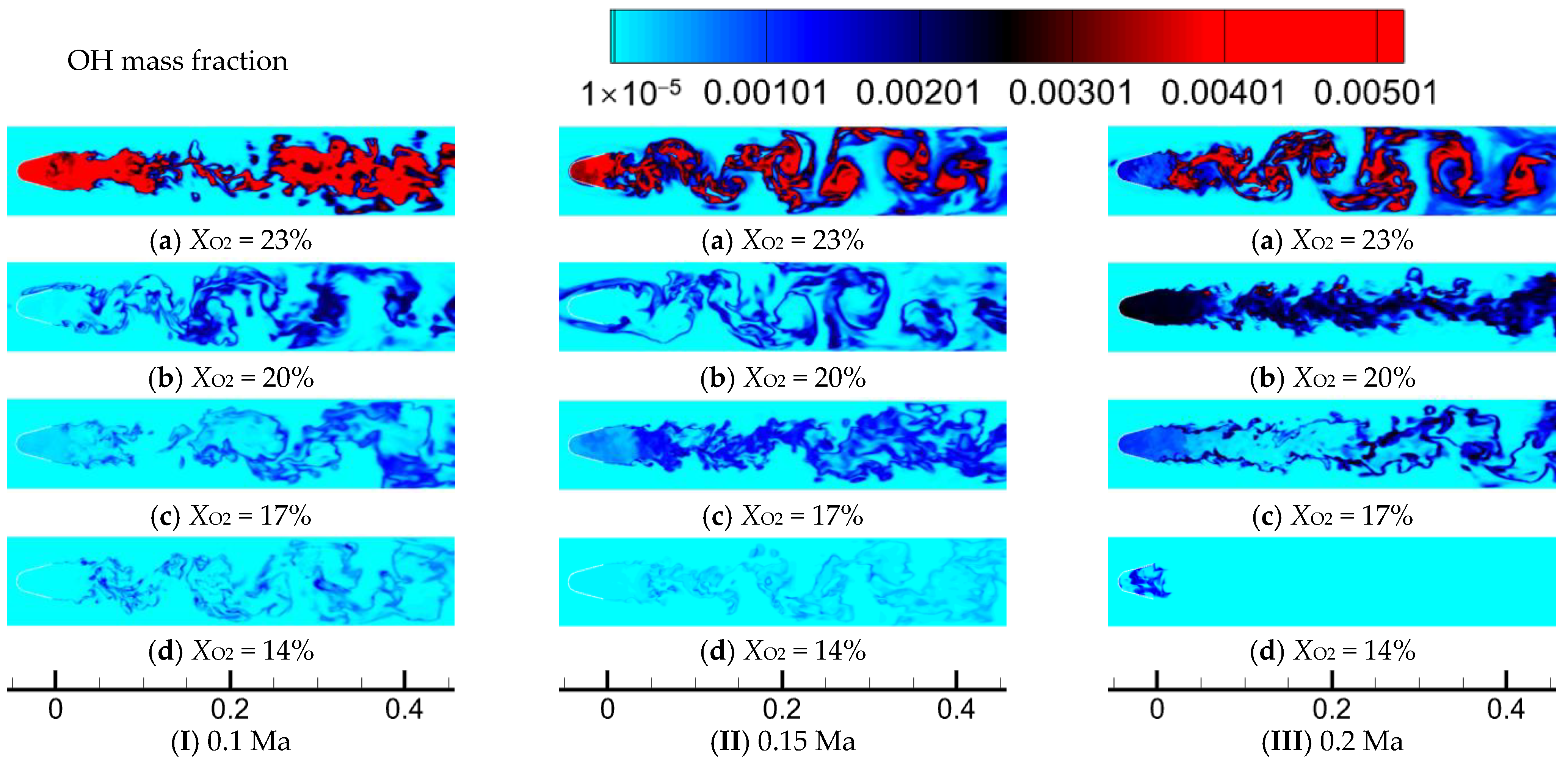Exploring Vortex–Flame Interactions and Combustion Dynamics in Bluff Body-Stabilized Diffusion Flames: Effects of Incoming Flow Velocity and Oxygen Content
Abstract
1. Introduction
2. Numerical Method
2.1. Large Eddy Simulation (LES) Model
2.2. Discrete Phase Model
2.3. Combustion Model
2.4. Numerical Configuration and Boundary Conditions
2.4.1. Model Structure
2.4.2. Meshing
2.4.3. Boundary Conditions
2.5. Model Verification
3. Results
3.1. Vortex Structure
3.2. Flame Structure
3.3. Spectral Analysis
4. Conclusions
Author Contributions
Funding
Data Availability Statement
Conflicts of Interest
References
- Feng, M.; Dai, X.; Zhang, F.; Liao, G.; Jiaqiang, E. Numerical investigation on film cooling and aerodynamic performance for gas turbine endwalls with upstream vane-type and cascade-type slots. Aerosp. Sci. Technol. 2024, 145, 108857. [Google Scholar] [CrossRef]
- Chen, Y.; Fan, Y.; Bai, X.-S.; Xu, L.; Shan, X.; Bi, Y.; Deng, Y.; Han, Q. Experimental study on combustion and flow resistance characteristics of an afterburner with air-cooled bluff-body flameholder. Aerosp. Sci. Technol. 2022, 123, 107488. [Google Scholar] [CrossRef]
- Lovett, J.; Brogan, T.; Philippona, D.; Kiel, B.; Thompson, T. Development Needs for Advanced Afterburner Designs. In Proceedings of the 40th AIAA/ASME/SAE/ASEE Joint Propulsion Conference and Exhibit 2004, Fort Lauderdale, FL, USA, 11–14 July 2004; p. 4192. [Google Scholar]
- Safdar, M.M.; Masud, J.; Mufti, B.; Naseer, H.U.; Farooq, A.; Ullah, A. Numerical modeling and analysis of afterburner combustion of a low bypass ratio turbofan engine. In Proceedings of the AIAA Scitech 2020 Forum, Orlando, FL, USA, 6–10 January 2020; p. 628. [Google Scholar]
- Deng, F.; Huang, X.; Cheng, S.; Zhang, Y.; Huang, Z.; Tang, H.; Zheng, H. Experimental and modeling study of NO2 addition effects on autoignition behavior of propylene. Combust. Flame 2024, 262, 113371. [Google Scholar] [CrossRef]
- Hanna, M.; Bardon, M.; Rao, V. Flame stabilization behind bluff bodies. In Proceedings of the 25th Joint Propulsion Conference, Monterey, CA, USA, 12–16 July 1989; p. 2801. [Google Scholar]
- Zhang, X.; Chiu, H. Numerical modeling of afterburner combustion. Int. J. Turbo Jet Engines 1987, 4, 251–262. [Google Scholar] [CrossRef]
- Yilmaz, H. Investigation of combustion and emission performance of a micro combustor: Effects of bluff body insertion and oxygen enriched combustion conditions. Int. J. Hydrogen Energy 2019, 44, 25985–25999. [Google Scholar] [CrossRef]
- Wu, G.; Lu, Z.; Pan, W.; Guan, Y.; Ji, C.Z. Numerical and experimental demonstration of actively passive mitigating self-sustained thermoacoustic oscillations. Appl. Energy 2018, 222, 257–266. [Google Scholar] [CrossRef]
- Stöhr, M.; Yin, Z.; Meier, W. Interaction between velocity fluctuations and equivalence ratio fluctuations during thermoacoustic oscillations in a partially premixed swirl combustor. Proc. Combust. Inst. 2016, 36, 3907–3915. [Google Scholar] [CrossRef]
- Kheirkhah, S.; Cirtwill, J.D.M.; Saini, P.; Venkatesan, K.; Steinberg, A.M. Dynamics and mechanisms of pressure, heat release rate, and fuel spray coupling during intermittent thermoacoustic oscillations in a model aeronautical combustor at elevated pressure. Combust. Flame 2017, 185, 319–334. [Google Scholar] [CrossRef]
- Zhou, L.; Zhu, Q.; Ning, X.; Ai, Y.; Zhang, H. Flow Pattern-and Forces-Susceptibility to Small Attack Angles for a Rectangular Cylinder. Ocean. Eng. 2024, 300, 117376. [Google Scholar] [CrossRef]
- Liu, Z.; Zhou, L.; Tang, H.; Wang, Z.; Zhao, F.; Ji, X.; Zhang, H. Primary instability, sensitivity and active control of flow past two tandem circular cylinders. Ocean. Eng. 2024, 294, 116863. [Google Scholar] [CrossRef]
- Lieuwen, T.; Shanbhogue, S.; Khosla, S.; Smith, C. Dynamics of bluff body flames near blowoff. In Proceedings of the 45th AIAA Aerospace Sciences Meeting and Exhibit, Reno, NV, USA, 8–11 January 2007; p. 169. [Google Scholar]
- Ghani, A.; Poinsot, T.; Gicquel, L.; Staffelbach, G. LES of longitudinal and transverse self-excited combustion instabilities in a bluff-body stabilized turbulent premixed flame. Combust. Flame 2015, 162, 4075–4083. [Google Scholar] [CrossRef]
- Baraiya, N.A.; Chakravarthy, S. Syngas combustion dynamics in a bluff-body turbulent combustor. Dyn. Control Energy Syst. 2020, 239–263. [Google Scholar]
- Hansson, A. Combustion Instability Progress in Astronautics and Aeronautics series Vol. 222. Aeronaut. J. 2009, 113, 492–493. [Google Scholar] [CrossRef]
- Cohen, J.; Anderson, T. Experimental investigation of near-blowout instabilities in a lean, premixed step combustor. In Proceedings of the 34th Aerospace Sciences Meeting and Exhibit, Reno, NV, USA, 15–18 January 1996. [Google Scholar]
- Lieuwen, T.C.; Yang, V. Combustion Instabilities in Gas Turbine Engines: Operational Experience, Fundamental Mechanisms, and Modeling; American Institute of Aeronautics and Astronautics: Reston, VA, USA, 2006; p. 44. [Google Scholar] [CrossRef]
- Hobson, D.E.; Fackrell, J.E.; Hewitt, G. Combustion instabilities in industrial gas turbines—Measurements on operating plant and thermoacoustic modeling. J. Eng. Gas Turbines Power 2000, 122, 420–428. [Google Scholar] [CrossRef]
- Hosseini, S.E.; Wahid, M.A. Investigation of bluff-body micro-flameless combustion. Energy Convers. Manag. 2014, 88, 120–128. [Google Scholar] [CrossRef]
- Noor, M.; Wandel, A.P.; Yusaf, T. Numerical study of oxygen dilution and temperature distribution of biogas combustion in Bluff-body MILD burner. In Proceedings of the 7th Australian Combustion Symposium (ACS 2013), Perth, Australia, 6–8 November 2013; pp. 299–303. [Google Scholar]
- Liu, C.; Zhang, J.; Yang, T.; Ma, Y. Bluff-Body Flames in Hot and Diluted Environments. In Proceedings of the ASME Power Conference 2018, Lake Buena Vista, FL, USA, 24–28 June 2018; p. V001T01A002. [Google Scholar]
- Roy, R.N.; Sreedhara, S. A numerical study on the influence of airstream dilution and jet velocity on NO emission characteristics of CH4 and DME bluff-body flames. Fuel 2015, 142, 73–80. [Google Scholar] [CrossRef]
- Mishra, D.; Kumar, P. Effects of N2 gas on preheated laminar LPG jet diffusion flame. Energy Convers. Manag. 2010, 51, 2144–2149. [Google Scholar] [CrossRef]
- Shanbhogue, S.J.; Husain, S.; Lieuwen, T. Lean blowoff of bluff body stabilized flames: Scaling and dynamics. Prog. Energy Combust. Sci. 2009, 35, 98–120. [Google Scholar] [CrossRef]
- Wan, J.; Fan, A.; Yao, H.; Liu, W. Experimental investigation and numerical analysis on the blow-off limits of premixed CH4/air flames in a mesoscale bluff-body combustor. Energy 2016, 113, 193–203. [Google Scholar] [CrossRef]
- Kalathoor, S.; Chakravarthy, S. Multi-Scale Computational Simulation of Combustion Instability and Transition in a Model Afterburner. In Proceedings of the Turbo Expo: Power for Land, Sea, and Air 2017, Charlotte, NC, USA, 26–30 June 2017; p. V04AT04A049. [Google Scholar]
- Lapenna, P.E.; Troiani, G.; Lamioni, R.; Creta, F. Mitigation of Darrieus–Landau instability effects on turbulent premixed flames. Proc. Combust. Inst. 2021, 38, 2885–2892. [Google Scholar] [CrossRef]
- Emerson, B.; O’Connor, J.; Juniper, M.; Lieuwen, T. Density ratio effects on reacting bluff-body flow field characteristics. J. Fluid Mech. 2012, 706, 219–250. [Google Scholar] [CrossRef]
- Erickson, R.; Soteriou, M.; Mehta, P. The influence of temperature ratio on the dynamics of bluff body stabilized flames. In Proceedings of the 44th AIAA Aerospace Sciences Meeting and Exhibit, Reno, NV, USA, 9–12 January 2006; p. 753. [Google Scholar]
- Deng, F.; Zhao, M.; Qin, S.; Wang, Z.; Xie, Y.; Zheng, H.; Liu, X.; Zhang, F. Numerical Simulation Study on the Dynamics of Bluff-Body Flames under Oxygen-Lean Conditions. Energies 2023, 17, 142. [Google Scholar] [CrossRef]
- Jadhav, K.; Chandy, A.J. Assessment of SGS models for large eddy simulation (LES) of a stratified Taylor–Green vortex. Flow Turbul. Combust. 2021, 106, 37–60. [Google Scholar] [CrossRef]
- Jakirlic, S.; Saric, S.; Kniesner, B.; Kadavelil, G.; Basara, B.; Chaouat, B. SGS modelling in LES of wall-bounded flows using transport RANS models: From a zonal to a seamless hybrid LES/RANS method. In Proceedings of the Sixth International Symposium on Turbulence and Shear Flow Phenomena, Seoul, Republic of Korea, 22–24 June 2009. [Google Scholar]
- Wang, B.-C.; Bergstrom, D.J. A dynamic nonlinear subgrid-scale stress model. Phys. Fluids 2005, 17, 035109. [Google Scholar] [CrossRef]
- Davidson, L.; Peng, S.-H. Hybrid LES-RANS modelling: A one-equation SGS model combined with ak–ω model for predicting recirculating flows. Int. J. Numer. Methods Fluids 2003, 43, 1003–1018. [Google Scholar] [CrossRef]
- Fröhlich, J.; Von Terzi, D. Hybrid LES/RANS methods for the simulation of turbulent flows. Prog. Aerosp. Sci. 2008, 44, 349–377. [Google Scholar] [CrossRef]
- Kuo, K.K. Principles of Combustion; John Wiley & Sons: New York, NY, USA, 1986. [Google Scholar]
- Xu, L.; Zhang, Y.; Tang, Q.; Johansson, B.; Yao, M.; Bai, X.-S. LES/FGM investigation of ignition and flame structure in a gasoline partially premixed combustion engine. Proc. Combust. Inst. 2023, 39, 4851–4860. [Google Scholar] [CrossRef]
- Kundu, K.; Penko, P.; VanOverbeke, T. A practical kinetic mechanism for computing combustion in gas turbine engines. In Proceedings of the 35th Joint Propulsion Conference and Exhibit, Los Angeles, CA, USA, 20–24 June 1999; p. 2218. [Google Scholar]
- Roach, J.; Fisher, T.; Frankel, S.; Sekar, B.; Kiel, B. Cfd predictions of damköhler number fields for reduced order modeling of v-gutter flame stability. In Proceedings of the 46th AIAA Aerospace Sciences Meeting and Exhibit, Reno, NV, USA, 7–10 January 2008; p. 509. [Google Scholar]
- Liu, X. Study on Low Emission Combustion Chambe Design and Premixed Combustion Characteristics. Ph.D. Thesis, Harbin Engineering University, Harbin, China, 2017. [Google Scholar]
- George, L.K.; Raja, S.K.; Srikrishnan, A.R.; Kannan, R. The influence of the geometry of V-gutter bluff body on transient vortex shedding. Int. J. Turbo Jet-Engines 2021, 4, 40. [Google Scholar] [CrossRef]
- Lundrigan, J. Effect of Flame Temperature Ratio on Bluff Body Wakes. Bachelor’s Thesis, Georgia Institute of Technology, Atlanta, GA, USA, 2012. [Google Scholar]
- Külsheimer, C.; Büchner, H. Combustion dynamics of turbulent swirling flames. Combust. Flame 2002, 131, 70–84. [Google Scholar] [CrossRef]
- Li, F.; Xu, L.; Yang, L.; Cao, Z. Experimental characterization of self-excited combustion pulsation in a thermoacoustic combustor. Fuel 2023, 334, 126423. [Google Scholar] [CrossRef]
- Berger, F.M.; Hummel, T.; Schuermans, B.; Sattelmayer, T. Pulsation-amplitude-dependent flame dynamics of high-frequency thermoacoustic oscillations in lean-premixed gas turbine combustors. J. Eng. Gas Turbines Power 2018, 140, 041507. [Google Scholar] [CrossRef]









| Pressure/MPa | Temperature/K | Mach Number | Oil-to-Gas Ratio | Oxygen Content/% | |
|---|---|---|---|---|---|
| Case1 | 0.1 | 900 | 0.1 | 0.03 | 14–23 |
| Case2 | 0.1 | 900 | 0.15 | 0.03 | 14–23 |
| Case3 | 0.1 | 900 | 0.2 | 0.03 | 14–23 |
Disclaimer/Publisher’s Note: The statements, opinions and data contained in all publications are solely those of the individual author(s) and contributor(s) and not of MDPI and/or the editor(s). MDPI and/or the editor(s) disclaim responsibility for any injury to people or property resulting from any ideas, methods, instructions or products referred to in the content. |
© 2024 by the authors. Licensee MDPI, Basel, Switzerland. This article is an open access article distributed under the terms and conditions of the Creative Commons Attribution (CC BY) license (https://creativecommons.org/licenses/by/4.0/).
Share and Cite
Chen, M.; Zhao, M.; Wang, Z.; Huang, X.; Zheng, H.; Deng, F. Exploring Vortex–Flame Interactions and Combustion Dynamics in Bluff Body-Stabilized Diffusion Flames: Effects of Incoming Flow Velocity and Oxygen Content. Processes 2024, 12, 622. https://doi.org/10.3390/pr12030622
Chen M, Zhao M, Wang Z, Huang X, Zheng H, Deng F. Exploring Vortex–Flame Interactions and Combustion Dynamics in Bluff Body-Stabilized Diffusion Flames: Effects of Incoming Flow Velocity and Oxygen Content. Processes. 2024; 12(3):622. https://doi.org/10.3390/pr12030622
Chicago/Turabian StyleChen, Mingmin, Minwei Zhao, Zhihao Wang, Xinbo Huang, Hongtao Zheng, and Fuquan Deng. 2024. "Exploring Vortex–Flame Interactions and Combustion Dynamics in Bluff Body-Stabilized Diffusion Flames: Effects of Incoming Flow Velocity and Oxygen Content" Processes 12, no. 3: 622. https://doi.org/10.3390/pr12030622
APA StyleChen, M., Zhao, M., Wang, Z., Huang, X., Zheng, H., & Deng, F. (2024). Exploring Vortex–Flame Interactions and Combustion Dynamics in Bluff Body-Stabilized Diffusion Flames: Effects of Incoming Flow Velocity and Oxygen Content. Processes, 12(3), 622. https://doi.org/10.3390/pr12030622





